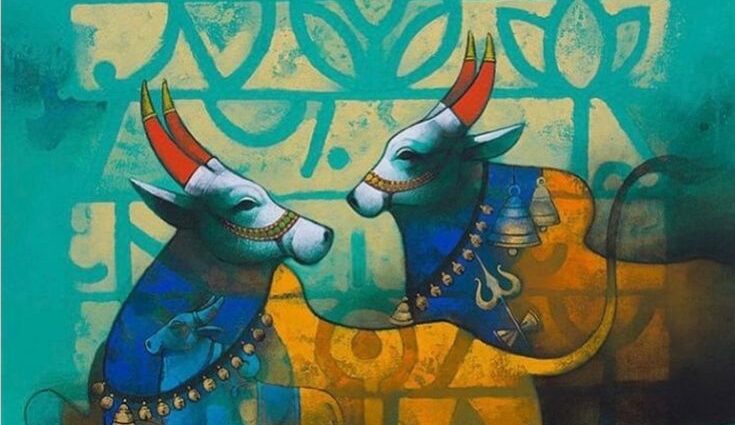This painting is a vibrant and symbolic piece of Indian contemporary art, blending traditional themes with a modern aesthetic. Here’s a detailed analysis:
Visual Description:
- Main Subjects:
The painting features two stylized bulls or Nandis, which are the sacred mounts of Lord Shiva in Hindu mythology. They are depicted in dynamic, playful motion, appearing almost as if dancing or frolicking. - Color Palette:
The dominant colors are turquoise, deep blue, mustard yellow, rusty orange, and hints of red. The background blends into the forms, creating a dreamlike, ethereal atmosphere. - Symbolism and Iconography:
- Nandi Bulls: Central to Hindu iconography, Nandi represents strength, devotion, and calmness. Their ornate decoration with bells, jewelry, and symbolic motifs (like the trident – Trishul) associates them with divinity.
- Trishul & Bells: These are traditional symbols associated with Lord Shiva—Trishul symbolizes power and protection, while the bells evoke a spiritual ambiance.
- Sacred Geometry and Script-like Patterns: The background is filled with abstract motifs, sacred symbols, and what resembles ancient Indus Valley script or Devanagari calligraphy, giving the painting a cultural and historical depth. The lotus shapes hint at purity and enlightenment.
- Layering and Texture:
The artist has used transparent layering, creating a sense of depth and movement. There’s a subtle interplay of light and shadow that gives the bulls a luminous quality.
Artistic Style:
- Modern Indian Art:
The piece reflects the style of many modern Indian artists who blend folk traditions, mythological narratives, and contemporary design elements. - Symbolic Abstraction:
Rather than being hyper-realistic, the bulls are abstracted, giving them a mythical, otherworldly essence. - Cultural Fusion:
There’s a strong presence of tribal, folk, and Tantric design elements merged with modern color theory and composition.
Possible Interpretation:
- Divine Play:
The image may represent the cosmic dance of devotion, with the Nandis as symbols of eternal loyalty to the divine. - Harmony of Opposites:
The contrasting yet complementary colors and directions of the bulls may indicate balance and harmony—between material and spiritual, action and stillness. - Cultural Memory:
The inclusion of script-like elements may represent the timelessness of Indian spiritual heritage, connecting past civilizations to the present.
Artist’s Intent:
While the specific artist is not mentioned, this kind of work suggests someone deeply inspired by Indian mythology and symbolism, possibly influenced by artists like Seema Kohli, Thota Vaikuntam, or Laxma Goud, who are known for similar thematic expressions.
